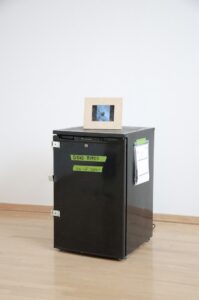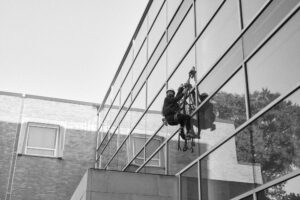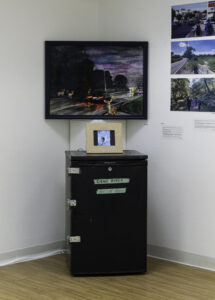If you’ve recently been to the Schuylkill Center, you may have noticed our gallery space is a bit more full than normal. In our current exhibition Walking the Edge, you’ll find hundreds of artworks, ranging from resin sculpture and vibrant photographs to large, earth-toned textiles. And since its debut, the most frequent question I hear is, “Are there really dead birds in that fridge?” This seems to be the response artist Matt Witmer hopes to elicit in viewers as he coyly refuses to reveal the truth.
Dead Bird Fridge first came to be during Witmer’s time as a graduate student at Temple University’s Tyler School of Art in 2021. Part of a larger thesis show, the artwork consists of a small refrigerator litteredwith bird feces, secured with FrogTape and padlocks, and featuring a multimedia picture frame looping images of birds killed from window strikes at Tyler, most commonly yellowthroats, ruby-crowned kinglets, and ovenbirds. As a graduate of Tyler myself, I am all too familiar with the jarring experience of hearing birds smack into the gargantuan windows, only to fall to their death moments later. These huge glass windows have become a popular aesthetic choice in modern architecture and are often spoken of as a gateway to the exterior world. Witmer sees bird strikes as an immediate challenge to a modernist way of thinking that fails to recognize our own embeddedness in the natural world.  Witmer says this artwork “documents the physical death toll of the imagined border between nature and civilization.” He often begins a project finding an infrastructure problem and “blowing it up” to discover what moral stance is implanted in the issue. In this case, glass architectural elements allow the viewer to look outside and feel connected to the natural world, but at the same time they isolate us from nature, and unfortunately, migratory birds are the indirect target of the violence perpetrated by these barriers. In fact, corporations and companies cannot be held accountable for causing avian deaths, but it is illegal for an individual to possess a migratory bird corpse because one can’t prove that they didn’t kill it. Witmer’s mysterious fridge toys with this indeterminate territory.
Witmer says this artwork “documents the physical death toll of the imagined border between nature and civilization.” He often begins a project finding an infrastructure problem and “blowing it up” to discover what moral stance is implanted in the issue. In this case, glass architectural elements allow the viewer to look outside and feel connected to the natural world, but at the same time they isolate us from nature, and unfortunately, migratory birds are the indirect target of the violence perpetrated by these barriers. In fact, corporations and companies cannot be held accountable for causing avian deaths, but it is illegal for an individual to possess a migratory bird corpse because one can’t prove that they didn’t kill it. Witmer’s mysterious fridge toys with this indeterminate territory.
We can imagine the creation of Dead Bird Fridge as a show, envisioning Witmer painstakingly searching out, collecting, and archiving these dead birds over many months. In fact, his graduate work culminated in a dystopian performance piece captured in video entitled The Last Bird, in which Witmer scaled the side of Tyler School of Art in an attempt to stop a fictional last bird left on earth from hitting the discreet windows. Viewers can’t help but find humor in the piece, especially in the reactions of clueless passing police. These artworks exist in gray areas, and just as we question if there are indeed birds in the padlocked fridge, we are left to contemplate the overall fate of these birds. In his research, Witmer made a connection to the Migratory Bird Treaty Act of 1918, a law that essentially made it illegal to possess corpses of migratory birds at a time when many birds were at risk of extinction. As a result, bird enthusiasts end up finding research institutions to take the birds, so Witmer started a relationship with The Academy of Natural Sciences as part of their collection project. The ambiguity of this knowledge is integral to the functioning of the piece, as viewers confront the possibility of corpses in a locked container. 
Witmer’s tone is quite cheeky in a world where environmental artistic practice tends to skew impossibly hopeful or completely doom and gloom – just check out his artist statement and you will understand. Witmer was raised by environmentalist parents and spent much of his childhood outside birding and hiking. In 2016, he hiked the entire Appalachian Trail, an experience that he admits changed both him and his art. Art and trash he found along the trail became integral to his practice as he shifted back to the real world after months on the trail. Due to this experience, Witmer admits he is frustrated with our approaches to the current environmental situation and notes that while hope is important, it is equally essential to avoid the spiral that happens when contemplating our Earth’s fate, and that’s where dark humor comes into play. He admits to sometimes putting on a metaphorical jester hat to “speak truth to power in the guise of a ridiculous buffoon.”
Moving forward, Witmer anticipates continuing his fascination and exploration of our waterways, and the Schuylkill River in general. Water, while a fundamental element of ecology, is something he sees as a force society is constantly trying to control rather than work with. Ultimately, the idea that nature exists in opposition to civilization is a construct, so the least we can do is laugh about it all – case in point – staging a perpetual video memorial, complete with a closed casket, for dead birds lost to forces that are invisible (at least to them).
By Kristina Murray, Director of Environmental Art.
Please visit the exhibition Walking the Edge, on view now through April 1, 2023.
Images
Installation view, “Dead Bird Fridge,” Schuylkill Center, 2023. Photographer: Ricky Yanas.
Matt Witmer, “Dead Bird Fridge,” 2021. Photo courtesy of the artist.
Still from “The Last Bird,” Tyler School of Art, October 27, 2021. Photo courtesy of the artist.

